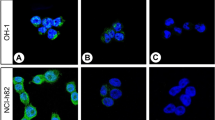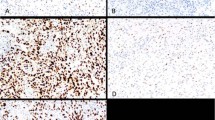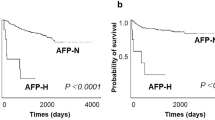Abstract
Study of the distribution of the p21 ras oncogene product as demonstrated by monoclonal antibody Y13-259 shows this protein to be apparently present in all epithelial populations of both premalignant and malignant tumours and throughout the normal foetal and adult epithelial crypt population in the colorectum. Metastatic tumour in liver shows a similar staining pattern which is less intense however than in the surrounding normal hepatocytes. Our results suggest that the presence of this protein is a widespread feature of normal cellular metabolism in certain cell types and is not restricted to those actively involved in cellular proliferation. It appears, furthermore, that neither cells at different stages of carcinogenesis nor those representing variants of a malignant phenotype can be identified using this particular antibody.
This is a preview of subscription content, access via your institution
Access options
Subscribe to this journal
Receive 24 print issues and online access
$259.00 per year
only $10.79 per issue
Buy this article
- Purchase on Springer Link
- Instant access to full article PDF
Prices may be subject to local taxes which are calculated during checkout
Similar content being viewed by others
Rights and permissions
About this article
Cite this article
Kerr, I., Lee, F., Quintanilla, M. et al. Immunocytochemical demonstration of p21 ras family oncogene product in normal mucosa and in premalignant and malignant tumours of the colorectum. Br J Cancer 52, 695–700 (1985). https://doi.org/10.1038/bjc.1985.245
Issue Date:
DOI: https://doi.org/10.1038/bjc.1985.245
This article is cited by
-
Professor Tom Connors and the development of novel cancer therapies by the Phase I/II Clinical Trials Committee of Cancer Research UK
British Journal of Cancer (2003)
-
Detection of rat gene alterations and ras proteins in colorectal cancer
Diseases of the Colon & Rectum (1989)
-
Ras oncogene and the acquisition of metastasizing properties by rectal adenocarcinoma
Diseases of the Colon & Rectum (1989)
-
Do all colorectal carcinomas arise in preexisting adenomas?
World Journal of Surgery (1989)
-
Enhanced expression of ras gene products in psoriatic epidermis
Archives of Dermatological Research (1988)



